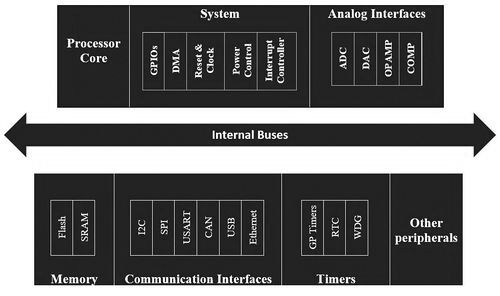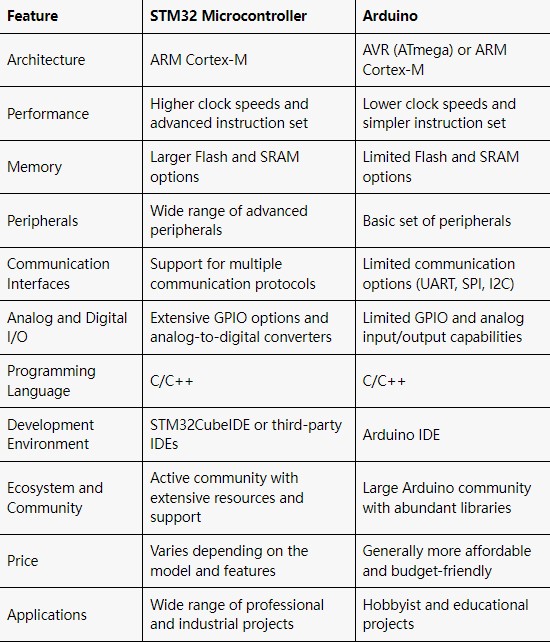Time: 2024-03-12 16:49:37View:
The STM32 microcontroller is a family of 32-bit microcontrollers developed by STMicroelectronics. It offers a wide range of performance, features, and memory options, making it a popular choice for various embedded systems and IoT (Internet of Things) applications. The STM32 microcontrollers are based on the ARM Cortex-M processor architecture, which provides a powerful and efficient platform for designing embedded systems.
The STM32 microcontroller ecosystem is supported by a vibrant and active community. Developers can access a wealth of resources, including documentation, application notes, forums, and online communities, where they can seek guidance, share knowledge, and collaborate with other STM32 enthusiasts.
With its powerful features, versatility, and extensive development support, the STM32 microcontroller family has gained popularity among both professional developers and hobbyists. It is widely used in a range of applications, including industrial automation, consumer electronics, healthcare devices, automotive systems, smart home technology, and many more. The STM32 microcontrollers continue to evolve, offering improved performance, advanced features, and enhanced connectivity options, enabling developers to create innovative and efficient embedded systems.

Here are some key features of STM32 microcontrollers:
Performance: STM32 microcontrollers are based on the ARM Cortex-M processor architecture, providing excellent performance for embedded applications. They offer a combination of high clock speeds, efficient instruction pipelines, and optimized execution units to handle complex tasks efficiently.
Memory Options: STM32 microcontrollers come with various memory options to accommodate different application requirements. They typically include Flash memory for storing program code and non-volatile data, as well as SRAM (Static Random Access Memory) for fast data storage and manipulation. Some models also feature additional memory options like EEPROM (Electrically Erasable Programmable Read-Only Memory) or external memory interfaces for expanding the available memory.
Peripherals: STM32 microcontrollers are equipped with a wide range of peripherals, including GPIO (General Purpose Input/Output) pins, timers, UART (Universal Asynchronous Receiver-Transmitter) interfaces, SPI (Serial Peripheral Interface), I2C (Inter-Integrated Circuit), ADC (Analog-to-Digital Converter), DAC (Digital-to-Analog Converter), PWM (Pulse-Width Modulation) controllers, and more. These peripherals enable easy interfacing with external devices, sensors, and communication interfaces.
Low-Power Capabilities: STM32 microcontrollers are designed with power efficiency in mind. They offer various low-power modes and features to optimize energy consumption, making them suitable for battery-powered applications and systems that require efficient power management.
Communication Interfaces: STM32 microcontrollers support a range of communication protocols, such as UART, SPI, I2C, CAN (Controller Area Network), USB (Universal Serial Bus), Ethernet, and more. These interfaces enable seamless connectivity and data exchange with other devices, sensors, and networks.
Analog and Digital Conversion: STM32 microcontrollers feature built-in ADCs and DACs, allowing precise analog-to-digital and digital-to-analog conversion. This enables the acquisition of analog signals from sensors and the generation of analog output signals for controlling actuators.
Real-Time Capabilities: STM32 microcontrollers offer real-time operating system (RTOS) support and provide features for deterministic and time-critical applications. They offer hardware support for interrupt handling, task scheduling, and real-time event triggering.
Security Features: STM32 microcontrollers incorporate various security features to protect sensitive data and ensure system integrity. These features include hardware encryption and decryption, secure boot mechanisms, and memory protection units.
Debugging and Development Tools: STM32 microcontrollers are supported by comprehensive debugging and development tools. Integrated development environments (IDEs) like STM32CubeIDE provide code editors, compilers, debuggers, and other utilities for efficient software development and debugging.
Ecosystem and Community: STM32 microcontrollers have a vibrant ecosystem with extensive documentation, application notes, and reference designs available from STMicroelectronics. The STM32 community offers forums and online resources where developers can find support, share knowledge, and collaborate with other STM32 enthusiasts.
Here's a comparison table highlighting some key differences between STM32 microcontrollers and Arduino:

Programming STM32 microcontrollers involves several steps to set up the development environment, write code, compile it, and flash it onto the microcontroller. Here is a breakdown of the process:
1. Selecting a Development Environment: Choose an integrated development environment (IDE) that supports STM32 microcontrollers. STMicroelectronics provides STM32CubeIDE, a powerful IDE specifically designed for STM32 development. Alternatively, you can use other IDEs compatible with ARM Cortex-M processors, such as Keil MDK or IAR Embedded Workbench.
2. Setting Up the Development Environment: Install the chosen IDE and any necessary software components, such as device drivers and SDKs. Ensure that the IDE is correctly configured with the appropriate compiler and debugger settings for STM32 microcontrollers.
3. Creating a New Project: Start by creating a new project in the IDE. Select the STM32 microcontroller series and specific model you are working with. The IDE will generate the initial project structure with necessary startup files, linker scripts, and device-specific configurations.
4. Writing Code: Begin coding the desired functionality for your STM32 microcontroller application. The code is typically written in the C programming language, although some IDEs support other languages like C++ or Assembly. Utilize the provided STM32Cube firmware libraries and peripheral drivers to interface with the microcontroller's peripherals effectively.
5. Configuring Peripherals: Use the IDE's graphical tools or code templates to configure the microcontroller's peripherals, such as GPIO pins, timers, UART, SPI, I2C, ADC, and DMA. This involves setting up registers, configuring interrupt handlers, and defining communication protocols as required by your application.
6. Building the Project: Compile the code to check for any syntax or compilation errors. The IDE will use the selected compiler to generate the binary file (usually in the form of a .hex or .bin file) that will be flashed onto the microcontroller.
7. Flashing the Microcontroller: Connect the STM32 microcontroller to the development board or programmer/debugger. Use the IDE's integrated flash programming utility or an external programmer/debugger to flash the compiled binary file onto the microcontroller's flash memory. This process ensures that the microcontroller runs the desired application code.
8. Debugging and Testing: Debugging tools provided by the IDE, such as breakpoints, watch windows, and real-time variable monitoring, help identify and fix any programming or logic errors. Use these tools to step through the code and observe the microcontroller's behavior in real-time. Additionally, perform thorough testing to ensure the desired functionality is achieved.
9. Optimizing and Deploying: Fine-tune the code and optimize it for performance and power efficiency, if necessary. Once the desired functionality is achieved and the application is thoroughly tested, prepare the code for deployment onto the target STM32 microcontroller. This may involve configuring low-power modes, optimizing interrupt handling routines, or implementing firmware update mechanisms.
10. Documentation and Maintenance: Document your code, including comments, function descriptions, and overall system architecture. This helps with code maintenance and allows other developers to understand and modify the codebase if necessary. Regularly update and maintain the codebase as your application evolves and new requirements emerge.
By following these steps and leveraging the resources and tools provided by the chosen IDE, developers can effectively program STM32 microcontrollers and unleash their full potential in a wide range of embedded system applications.